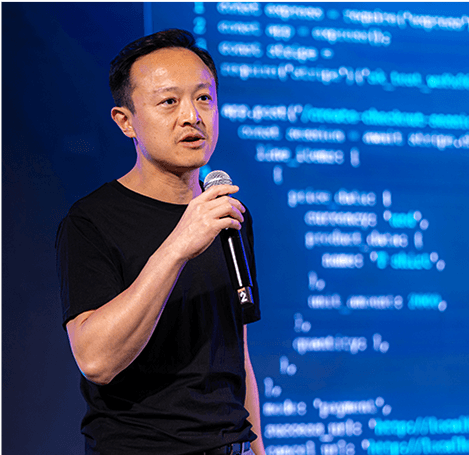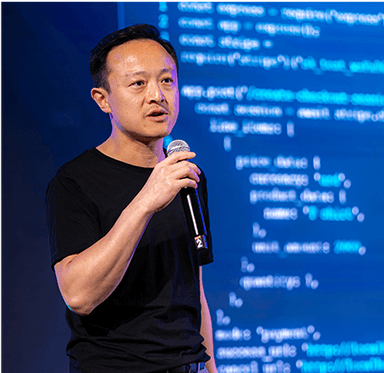AI Agents x LightLink: Building Fully Autonomous On-Chain Bots With ElizaOS


Learn how to build autonomous AI agents on LightLink using ElizaOS. This step-by-step guide covers setup, plugins, DeFi integrations, and real-world use cases for blockchain-powered AI agents.
The convergence of AI and blockchain is unearthing a new class of applications: fully autonomous agents that can interact seamlessly with decentralized networks. AI agents are becoming one of the most exciting use cases for blockchain; not just interacting with on-chain systems, but operating entirely on their own.
The LightLink Plugin allows agents to integrate directly with the LightLink network, enabling sophisticated AI agents to perform blockchain operations autonomously.
In this guide, LightLink blockchain developer Dan H walks you through how to leverage the @elizaos/plugin-lightlink to build powerful AI agents that can operate seamlessly on the LightLink network.
What is LightLink?
LightLink is a Layer 2 blockchain secured by Ethereum, purposefully built for Metaverse, NFT and Gaming applications. The network consists of two main environments:
- Phoenix Mainnet: Phoenix is the main network with Chain ID: 1890
- Pegasus Testnet: Pegasus is a test network used for development and testing
What makes LightLink particularly attractive for AI agents is its focus on reducing friction in blockchain interactions, offering gasless transactions through its native DEX ecosystem.
Introduction to ElizaOS
ElizaOS is a comprehensive framework for building AI agents with persistent personalities across multiple platforms. The framework provides a modular architecture that allows developers to create sophisticated agents through:
- Character Files: JSON configurations that define personality and behavior
- Providers: Components that gather context before response generation
- Actions: Define what the agent can do and generate responses
- Evaluators: Assess agent performance and behavior
- Plugins: Extend functionality for specific platforms or services
The core concepts of ElizaOS, including Agents, Character Files, Providers, Actions, and Evaluators, together form a highly controllable and orchestrated framework focused on the Web3 industry.
The LightLink Plugin: Core Capabilities
The @elizaos/plugin-lightlink brings comprehensive blockchain functionality to your AI agents. The plugin lets agents: Check balances, Transfer both ERC20 and Eth, Swap (via Elektrik), Search the block explorer for contracts and addresses.
Key Features
Balance Management
- Query ETH and ERC20 token balances
- Support for ENS name resolution
- Multi-address balance checking
Token Transfers
- Native ETH transfers
- ERC20 token transfers
- Cross-chain compatible design
DEX Integration
- Automated token swaps via Elektrik DEX
- Liquidity pool interactions
- Real-time price discovery
Block Explorer Integration
- Contract address lookup
- Transaction verification
- Network analytics
Getting Started: Installation and Setup
Installation
pnpm add @elizaos/plugin-lightlink
Environment Configuration
The plugin requires minimal configuration to get started:
# Required
EVM_PRIVATE_KEY=your-private-key-here
# Optional - Custom RPC URLs
LIGHTLINK_MAINNET_RPC_URL=https://your-custom-mainnet-rpc-url
LIGHTLINK_TESTNET_RPC_URL=https://your-custom-testnet-rpc-url
Character Configuration
By default, LightLink Phoenix (mainnet) is enabled. To enable additional chains, add them to your character config:
{
"settings": {
"chains": {
"evm": [
"lightlinkTestnet",
"ethereum",
"sepolia"
]
}
}
}
Building Your First LightLink AI Agent
Let's create a practical example of an AI agent that can manage a DeFi portfolio on LightLink.
Character Definition
{
"name": "DeFiPortfolioAgent",
"username": "defi_agent",
"bio": [
"AI agent specialized in DeFi portfolio management on LightLink",
"Can execute trades, monitor balances, and optimize yield strategies"
],
"lore": [
"Born from the need to democratize DeFi access",
"Specializes in LightLink ecosystem optimization"
],
"knowledge": [
"Deep understanding of AMM mechanics",
"Expertise in yield farming strategies",
"Real-time market analysis capabilities"
],
"messageExamples": [
[
{
"user": "user",
"content": {
"text": "What's my ETH balance on LightLink?"
}
},
{
"user": "DeFiPortfolioAgent",
"content": {
"text": "Let me check your ETH balance on LightLink Phoenix mainnet."
}
}
]
],
"postExamples": [
"Successfully executed a 1.5 ETH to USDC swap on Elektrik DEX",
"Portfolio rebalancing complete - optimized for current market conditions"
],
"settings": {
"chains": {
"evm": ["lightlinkTestnet", "lightlink"]
}
},
"plugins": ["@elizaos/plugin-lightlink"]
}
Core Agent Actions
Balance Monitoring
Check the balance of an address. All address can be written as an ENS name or a raw address:
Check the balance of vitalik.eth on lightlink
Automated Transfers
Transfer native tokens on the same chain:
Transfer 1 ETH to 0x742d35Cc6634C0532925a3b844Bc454e4438f44e
Intelligent Swapping
Swap tokens on the same chain, you can also provide the address of the tokens you want to swap directly:
Swap 1 ETH to USDC on lightlink testnet
Contract Discovery
Search the block explorer for contracts and addresses:
Whats the contract address for the USDC (sometimes written as USDC.e) token on lightlink?
Advanced Integration: Elektrik DEX
Elektrik is the premier decentralized exchange on the LightLink network. The Elektrik DEX brings gasless trading, advanced AMM features like limit orders, iceberg orders, and smart rebalancing; allowing AI agents to optimize trading without worrying about fees or manual execution.
Gasless Trading Experience
This not only enhances the trading experience, it also incentivizes governance participation and increases yield for protocol participants. Your AI agents can execute trades without worrying about gas optimization strategies.
Advanced Trading Features
It stands out with its abstracted AMM that introduces advanced trading features such as iceberg orders, limit orders, stop losses, and conditional orders, empowering traders with greater control and flexibility in their strategies.
Capital Efficiency
By implementing gasless rebalancing smart contracts, Elektrik optimizes capital efficiency, reduces impermanent loss risks and boosts liquidity provider returns.
Real-World Use Cases
Yield Optimization Agent
Create an agent that continuously monitors yield opportunities across LightLink protocols:
// Pseudo-code for yield optimization logic
const optimizeYield = async (agent) => {
const balance = await agent.checkBalance("ETH");
const opportunities = await agent.scanYieldOpportunities();
if (opportunities.bestAPY > currentPosition.APY + threshold) {
await agent.executeRebalance(opportunities.bestStrategy);
}
};
Portfolio Rebalancing Agent
Implement dollar-cost averaging and portfolio rebalancing:
// Pseudo-code for portfolio rebalancing
const rebalancePortfolio = async (agent, targetAllocation) => {
const currentBalances = await agent.getAllBalances();
const rebalanceActions = calculateRebalance(currentBalances, targetAllocation);
for (const action of rebalanceActions) {
if (action.type === 'swap') {
await agent.executeSwap(action.from, action.to, action.amount);
}
}
};
Arbitrage Detection Agent
Monitor price differences across DEXes for arbitrage opportunities:
// Pseudo-code for arbitrage detection
const detectArbitrage = async (agent) => {
const elektrikPrices = await agent.getElektrikPrices();
const externalPrices = await agent.getExternalPrices();
const opportunities = findArbitrageOpportunities(elektrikPrices, externalPrices);
for (const opportunity of opportunities) {
if (opportunity.profitThreshold > minProfitThreshold) {
await agent.executeArbitrage(opportunity);
}
}
};
Best Practices and Security Considerations
Private Key Management
Always use environment variables for sensitive data and consider implementing key rotation:
# Use secure key storage
EVM_PRIVATE_KEY=0x... # Store securely, rotate regularly
Error Handling
Implement robust error handling for blockchain operations:
try {
const result = await agent.transfer("1 ETH", recipientAddress);
console.log("Transfer successful:", result.transactionHash);
} catch (error) {
console.error("Transfer failed:", error.message);
// Implement retry logic or alert mechanisms
}
Rate Limiting
Respect RPC rate limits and implement proper queuing:
const rateLimitedCall = async (operation) => {
await delay(CONFIG.RATE_LIMIT_DELAY);
return await operation();
};
Transaction Monitoring
Always verify transaction success:
const executeWithConfirmation = async (operation) => {
const tx = await operation();
const receipt = await waitForTransactionReceipt(tx.hash);
if (receipt.status !== 'success') {
throw new Error(`Transaction failed: ${tx.hash}`);
}
return receipt;
};
Development Workflow
Local Development
Clone the repository, Install dependencies: pnpm install, Build the plugin: pnpm run build, Run tests: pnpm test
Testing Strategy
- Unit Tests: Test individual agent actions
- Integration Tests: Test plugin interactions with LightLink testnet
- End-to-End Tests: Simulate complete user workflows
Deployment Considerations
- Use LightLink Pegasus testnet for initial testing
- Gradually migrate to Phoenix mainnet with small amounts
- Implement monitoring and alerting systems
- Set up proper logging for transaction tracking
Performance Optimization
Batch Operations
Group multiple operations to reduce network calls:
const batchedOperations = async (agent, operations) => {
const promises = operations.map(op => agent.execute(op));
return await Promise.all(promises);
};
Caching Strategy
Implement intelligent caching for frequently accessed data:
const cachedBalanceCheck = async (address, maxAge = 30000) => {
const cached = cache.get(address);
if (cached && Date.now() - cached.timestamp < maxAge) {
return cached.balance;
}
const balance = await agent.checkBalance(address);
cache.set(address, { balance, timestamp: Date.now() });
return balance;
};
Future Roadmap and Opportunities
The LightLink ecosystem continues to evolve, with new opportunities emerging for AI agent developers:
Upcoming Features
- Enhanced DEX aggregation capabilities
- Cross-chain bridge integrations
- Advanced analytics and reporting tools
- Governance participation automation
Community Contributions
The plugin is open-source and welcomes community contributions. Areas for enhancement include:
- Additional DEX integrations
- Advanced trading strategies
- Improved error handling
- Performance optimizations
The Future of Autonomous On-Chain Agents
The @elizaos/plugin-lightlink opens up powerful possibilities for developers looking to create AI agents that can autonomously interact with the LightLink blockchain ecosystem. By combining ElizaOS's robust agent framework with LightLink's efficient Layer 2 infrastructure and Elektrik's advanced DEX features, developers can build sophisticated agents capable of complex DeFi operations.
The key to success lies in starting simple, implementing robust error handling, and gradually expanding capabilities as you become more familiar with the platform. Whether you're building yield optimization agents, portfolio managers, or arbitrage bots, the LightLink plugin provides the foundation for creating truly autonomous blockchain agents.
As the Web3 space continues to evolve, AI agents will play an increasingly important role in making blockchain technology more accessible and efficient. The LightLink plugin for ElizaOS represents a significant step forward in this direction, providing developers with the tools they need to build the next generation of intelligent blockchain applications.
Ready to build your own AI agents?
The LightLink Plugin repository makes it easy to launch AI agents that interact natively with blockchain. Explore the LightLink Plugin repository, experiment with ElizaOS, and unlock new use cases for autonomous on-chain agents.
Whether you're building AI agents, reimagining digital infrastructure, or exploring new applications across finance, urban tech, or real-world assets; LightLink provides the stack to support your vision.
Join our growing community of developers, founders, and builders across X, Discord, Telegram, and LinkedIn. Be part of shaping a smarter, more connected Web3 future.






